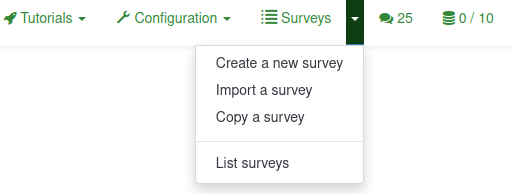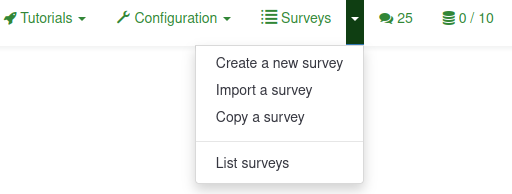Surveys - introduction/fr: Difference between revisions
From LimeSurvey Manual
(Updating to match new version of source page) |
No edit summary |
||
| (36 intermediate revisions by 4 users not shown) | |||
| Line 3: | Line 3: | ||
{{Alert|title=Attention|text= | {{Alert|title=Attention|text=Veuillez noter que ce tutoriel comporte des explications et des copies d'écran concernant LimeSurvey 3.xx. De légères différences existent entre LimeSurvey 3.xx et LimeSurvey 2.xx, plus spécifiquement pour ce qui a trait à l'interface graphique utilisateur (GUI). Nous recommandons l'usage de la dernière version de LimeSurvey.}} | ||
=Général= | |||
Plusieurs paramètres interconnectés dans la base constituent un questionnaire : ceux des langages, des groupes de questions, des questions, des attributs des questions, des réponses, des sous-questions, des réponses par défaut, des évaluations, des quotas, des membres des quotas et des langages de quota. Pour faciliter la [[Surveys - introduction#Surveys|gestion des questionnaires]], une nouvelle fonctionnalité a été introduite {{NewIn|3.0}}, il s'agit des [[Surveys - introduction#Survey groups|groupes de questionnaires]]. | |||
=Les questionnaires= | |||
Il y a deux manières d'atteindre la page '''[[Surveys - introduction#Create a new survey|créer un nouveau questionnaire]]''': | |||
<div class="mw-translate-fuzzy"> | |||
1. La première façon est de cliquer sur la flèche à côté du bouton '''Questionnaires''' situé dans la barre d'outil principale de l'accueil de LimeSurvey. Une liste déroulante apparaît qui vous proposera l'option '''Créer un nouveau questionnaire''' : | |||
</div> | |||
<center>[[File:createnewsurvey.png]]</center> | <center>[[File:createnewsurvey.png]]</center> | ||
2. | <div class="mw-translate-fuzzy"> | ||
2. La seconde est de cliquer directement sur ce bouton '''Questionnaires''' : | |||
</div> | |||
<center>[[File:Surveys-alternative button.png]]</center> | <center>[[File:Surveys-alternative button.png]]</center> | ||
<div class="mw-translate-fuzzy"> | |||
Une liste des questionnaires s'affiche. Pour créer un nouveau questionnaire, cliquez sur le bouton '''Créer un nouveau questionnaire''' situé en haut à gauche de la fenêtre, au-dessus de la liste de questionnaires. | |||
</div> | |||
<center>[[File:Create a new survey alternative.png]]</center> | <center>[[File:Create a new survey alternative.png]]</center> | ||
==Créer un nouveau questionnaire== | |||
<div class="mw-translate-fuzzy"> | |||
Après le clic sur '''Créer un nouveau questionnaire''', la page suivante s'affiche : | |||
</div> | |||
(1) Saisissez le '''Titre de l'enquête'''. | |||
'''Note''' : Le champ Titre de l'enquête est obligatoire. Les champs restants sont facultatifs. Pour une explication détaillée de chaque champ, veuillez vous référer à la section Éléments de texte ci-dessous. | |||
(2) Cliquez sur '''Enregistrer''' (En haut à droite juste en dessous de votre '''Nom d'utilisateur'''). | |||
<center>[[File:newsurveyscreen.png]]</center> | <center>[[File:newsurveyscreen.png]]</center> | ||
Pour ajuster les options disponibles pour votre questionnaire, vous pouvez parcourir les différents onglets présents dans la barre d'outils '''Paramètres''' : | |||
*[[Surveys - introduction#General settings|Paramètres généraux]] | |||
*[[Surveys - introduction#Text elements|Éléments de texte]] | |||
*[[Surveys - introduction#|Politique de confidentialité]] | |||
*[[Surveys - introduction#|Options de thème]] | |||
*[[Surveys - introduction#Presentation & navigation|Présentation]] | |||
*[[Surveys - introduction#Participant settings|Paramètres de participation]] | |||
*[[Surveys - introduction#Notification & data management|Notifications & données]] | |||
*[[Surveys - introduction#Publication & access control|Publication & accès]] | |||
*[[Surveys - introduction#Text elements|Text elements]] | *[[Surveys - introduction#Text elements|Text elements]] | ||
*[[Surveys - introduction#General settings|General settings]] | *[[Surveys - introduction#General settings|General settings]] | ||
| Line 40: | Line 72: | ||
*[[Surveys - introduction#Participant settings|Participant settings]] | *[[Surveys - introduction#Participant settings|Participant settings]] | ||
=== | {{Box|You can also re-edit most of these settings by accessing the [[Survey settings|settings menu]] of the newly created survey and editing the desired options.}} | ||
{{Alert|title=Attention|text=The HTML WYSIWYG editor does not allow you to upload files during the survey creation process. Doing so will cause an error message: E.g., "This file uploader is disabled". If you need to upload pictures or other resources, please do so after the survey creation by accessing the [[Resources|resources panel]] from the [[Survey settings|survey settings menu]].}} | |||
===Les éléments textuels=== | |||
Les options suivantes sont disponibles sur cet onglet : | |||
*''' | *'''Titre du questionnaire''' Le titre du questionnaire peut être modifié depuis ce champ; | ||
*''' | <div class="mw-translate-fuzzy"> | ||
{{Alert|title=Attention|text= | *'''Créer un exemple de question et groupe de question ?:'''{{NewIn|3.0}} Si c'est activé, une question et un groupe de question par défaut seront ajoutés à votre questionnaire lorsque vous créez celui-ci; | ||
{{Alert|title=Attention|text=Il est à noter qu'une question doit d'abord être ajoutée à un groupe de question pour apparaître dans le questionnaire! Sinon la question ne sera pas montrée au participant du questionnaire.}} | |||
</div> | |||
*'''Base | *'''Base Language''': This represents the main language of the survey. If you wish to add other survey languages, first create a survey, then access the [[General_settings#General_settings_panel|general settings]] of the newly created survey and add ''additional languages''. | ||
*'''Description:''' You can type in a survey description. If enabled from the [[Global settings|global settings]], use the [[Global_settings#General|HTML editor]] to better customize the description field | *'''Description:''' You can type in a survey description. If enabled from the [[Global settings|global settings]], you can use the [[Global_settings#General|HTML editor]] to better customize the description field. | ||
*'''End URL:''' You have the possibility to redirect users to another page when they finish filling out the questionnaire. If you wish to redirect them, type in the URL and activate the '''automatically load URL''' option that is located under the [[Surveys - introduction#Presentation & navigation|Presentation & navigation tab]] | *'''End URL:''' You have the possibility to redirect users to another page when they finish filling out the questionnaire. If you wish to redirect them, type in the URL and activate the '''automatically load URL''' option that is located under the [[Surveys - introduction#Presentation & navigation|Presentation & navigation tab]]. | ||
*'''URL | *'''URL Description:''' A short end URL description can be added in instances where the user is redirected to a non-related survey webpage. It may help if the survey administrator adds notes relating to the usage of the respective URL. | ||
*'''Date | *'''Date Format:''' This option is important when you want to record [[Surveys - introduction#Notification & data management|timestamps]] together with the survey participants' answers. If you click on it, a drop-down list will show up with a several date formats. Choose the date format used in the geographical location of your respondents. Do not forget that different date formats are used across the world. For example, it is recommended that you use a different time format if your questionnaire focuses on the US market (mm-dd-yyyy) and not on the British market (dd-mm-yy). | ||
*'''Decimal | *'''Decimal Mark:''' Two options are available: dot (.) and comma (,). Choose the one that fits the place (the geographical location) where you conduct your study (e.g. US vs Germany). | ||
*'''Welcome | *'''Welcome Message:''' Type in a message that will welcome the survey participants when they access your survey link. | ||
*'''End | *'''End Message:''' Type in a message that will be displayed to the survey participants once they finish the questionnaire. If the '''end URL''' field is [[Surveys - introduction#Presentation & navigation|automatically loaded]], the end message is no longer displayed. | ||
=== | ===Paramètres généraux=== | ||
Les options suivantes sont disponibles sur cet onglet : | |||
<center>[[File:Create a new survey - General settings.png]]</center> | <center>[[File:Create a new survey - General settings.png]]</center> | ||
*'''Survey Owner:''' Type in the real name of the survey owner. | |||
*'''Administrator:''' The name of the administrator. | |||
*'''Admin Email:''' Type in the email address of the survey administrator. | |||
{{Note|'''Administrator''' and '''admin email''' are managed in the LimeSurvey [[Email templates|email templates]] system.}} | |||
<div class="simplebox">[[File:help.png]]Many hosting providers' SMTP servers will only accept emails whose "From" address is on a local domain. All emails that do not conform to this rule are discarded silently, without any visible error message. If this happens, ensure that you are using a provider-based email address in the "Admin Email" field. You could also set up email forwarding on the provider's side, so that any messages sent there are forwarded to your preferred address.</div> | |||
{{Note|'''Administrator''' and '''admin email''' are | |||
<div class="simplebox">[[File:help.png]]Many hosting providers' SMTP servers will only accept emails whose "From | |||
*'''Bounce email:''' This is the email address where the delivery error notification emails (bounced emails) will be sent to. | *'''Bounce email:''' This is the email address where the delivery error notification emails (bounced emails) will be sent to. | ||
<div class="simplebox">[[File:help.png]] A bounce email is an electronic email which is returned to the sender | <div class="simplebox">[[File:help.png]] A bounce email is an electronic email which is returned to the sender for various reasons (e.g. invalid address, temporary unavailable mail server, the recipient's mailbox is full, etc).</div> | ||
*'''Fax | *'''Fax To:''' This field is used to print a fax number on the "printable survey" - i.e.: when you want to send someone a hard copy because he or she cannot use the online survey. | ||
*'''Group'''{{NewIn|3.0}}''':''' Select the [[Surveys - introduction#Survey groups|survey group]] the newly created survey should be added to | *'''Group'''{{NewIn|3.0}}''':''' Select the [[Surveys - introduction#Survey groups|survey group]] that the newly created survey should be added to. | ||
*'''Format:''' | *'''Format:''' This function allows you to choose the way in which the questions will be displayed to the survey respondents. Three options are available: | ||
**''Question by Question'' : The questions will be displayed one by one (one question per page). If this option is | **''Question by Question'' : The questions will be displayed one by one (one question per page). If this option is chosen, a separate "welcome" page and "end" page will be displayed when taking the survey. | ||
**''Group by Group'' : Each survey page will display a question group. Also, a separate "welcome" page and "end" page will | **''Group by Group'' : Each survey page will display a question group. Also, a separate "welcome" page and "end" page will be displayed when taking the survey, as with the "Question by Question" surveys. | ||
**''All | **''All In One'' : If chosen, all the pages will be displayed on a single page. If you select this option, no separate pages will be displayed for the "welcome" and "end" pages - they will all appear on the same page, together with the questions. | ||
*'''Template:''' The default template is rather simple, but functional. More information on creating your own templates is available [[Theme editor|here]]. | *'''Template:''' The default template is rather simple, but functional. More information on creating your own templates is available [[Theme editor|here]]. | ||
===Presentation & navigation=== | ===Presentation & navigation=== | ||
The following options can be found under | The following options can be found under the Presentation & Navigation tab: | ||
| Line 108: | Line 138: | ||
*'''Navigation | *'''Navigation Delay (Seconds):''' This feature displays the number of seconds before the previous, next, and submit buttons are enabled. If none is specified, the option will use the default value, which is "0" (seconds). | ||
*'''Show | *'''Show Question Index / Allow Jumping:''' A question index can be displayed in the survey if this function is enabled, allowing the user to jump from one question group to another. You can choose the following: | ||
**''Disabled'' : If this option is | **''Disabled'' : If this option is selected, no index is shown in the survey. | ||
**''Incremental'' : If this option is selected, the question groups will be shown incrementally in an index menu located on the survey page. You are allowed " | **''Incremental'' : If this option is selected, the question groups will be shown incrementally in an index menu located on the survey page. You are allowed to "jump back" only to the question groups that were previously visited/accessed. | ||
**''Full'' : Jumping from question group to question group is allowed via the index menu. | **''Full'' : Jumping from question group to question group is allowed via the index menu. | ||
*'''Show | *'''Show "There Are X Questions In This Survey"''': This shows the total number of questions in your survey. | ||
*'''Show Group Name and/or Group Description:''' This function allows you to choose whether your survey will show participants the question group name only, the group description only or both. You may also choose to hide both. | |||
*'''Show | *'''Show Question Number and/or Code:''' This function allows you to choose whether your survey will show participants the question number only, the question code only or both. You may also choose to hide both. Please note, the question number is shown the moment someone starts the survey, while the question code is shown next to each survey question. | ||
*'''Show | *'''Show "No Answer":''' When a ''"radio button"'' or ''"select type"'' question that contains editable answers (e.g.: List & Array questions) has the '''Show "No Answer"''' option enabled and it is also '''not mandatory''', an additional entry "No Answer" is displayed for each question/sub-question. In this way, the respondents may choose not to answer the respective question/sub-question. The following two options are available for survey administrators: | ||
*''' | **''On'' : If this option is selected, the respondents can choose the "No Answer" option for a non-mandatory question. | ||
**''Off'' : If selected, the "No Answer" option will not be displayed as a possible answer for any non-mandatory question. | |||
{{Box|Options set in the [[Global settings#Presentation|global settings]] override all other survey settings. Therefore, if the super-administrator chooses to have the "No Answer" option displayed, then the '''Show "No Answer"''' of the local survey field becomes non-selectable. The same applies to the ''"Off"'' option. To offer freedom to survey administrators, the super-administrator has to choose "Selectable" for the '''Show "No Answer"''' option from the global settings of your LimeSurvey installation.}} | |||
*'''Show Welcome Screen:''' If turned off, the welcome text message will not be displayed at the beginning of the questionnaire. | |||
*'''Allow Backward Navigation:''' If enabled, this will allow the users to navigate backwards and change his or her previous answers. | |||
*'''Show | *'''Show On-Screen Keyboard:''' If turned on, an on-screen keyboard will will be displayed when answering questions that require typing in information. | ||
*''' | *'''Show Progress Bar:''' When enabled, this function displays a progress bar that shows participants how much of the survey they have completed and how much is left to be completed. | ||
*''' | *'''Participants May Print Answers:''' If turned on, the survey participants may choose at the end of the survey to print their answers. | ||
*''' | *'''Public Statistics:''' A link to a set of statistics will be shown at the end of the survey if this option is enabled. | ||
*''' | *'''Show Graphs In Public Statistics:''' If enabled, graphs will also be shown in the Public Statistics at the end of the survey. Please note that the "Public Statistics" option has to be enabled to allow the survey participants to see the graphs. | ||
*'''Automatically Load URL When Survey Complete:''' The end URL becomes a redirect link once the survey is completed if this option is turned on. | |||
*'''Automatically | |||
===Publication & access control=== | ===Publication & access control=== | ||
The following | The following options can be found under the Publication & Access Control tab: | ||
| Line 161: | Line 182: | ||
*'''Start | *'''Start Date/Time:''' This is the date/time the survey starts. | ||
*'''Expiry | *'''Expiry Date/Time:''' This function allows you to choose a date for your survey to expire. This is the last date on which the public survey script will let people participate. (Example: If you set the expiry date for the 31st of December, then people will no longer be able to fill out the survey on the 1st of January). To remove an expiry date, just clear the date from the input field. | ||
*'''List | *'''List Survey Publicly:''' The default value is "No". When it is set to "Yes", your survey will be listed in the "Available Surveys" portal where it can be seen by all [[Manage users|LimeSurvey users]]. | ||
*'''Set | *'''Set Cookie to Prevent Repeated Participation:''' If this is turned on, a survey participant will be blocked from completing a survey a second time. | ||
*'''Use CAPTCHA for | *'''Use CAPTCHA for Survey Access:''' In order to access the survey, a CAPTCHA code has be typed in by the survey participant. | ||
*'''Use CAPTCHA for | *'''Use CAPTCHA for Registration:''' In order to register for the survey, a CAPTCHA code has be typed in by the survey participant. | ||
*'''Use CAPTCHA for | *'''Use CAPTCHA for Save and Load:''' Enable this function if you want a survey participant to type in a CAPTCHA code when he or she loads the survey again after only a part of it was completed (to prevents automated responses). | ||
===Notification & data management=== | ===Notification & data management=== | ||
The following options | The following options can be found under the Notification & Data Management tab: | ||
| Line 183: | Line 204: | ||
*'''Date | *'''Date Stamp:''' Enable this functionality if you would like to see the time when the answers were submitted. | ||
*'''Save IP | *'''Save IP Address:''' If "yes" is selected, the IP address of the survey respondent will be stored together with his or her answers. | ||
*'''Save | *'''Save Referrer URL:''' If "yes" is selected, the referrer URL will be stored together with the answers. | ||
*'''Save | *'''Save Timings:''' If this functionality is enabled, the time spent on each page of the survey by each participant is recorded. | ||
*'''Enable | *'''Enable Assessment Mode:''' You can enable/disable assessments for this survey with this setting. | ||
*'''Participant | *'''Participant May Save and Resume Later:''' This setting allows a participant to save his/her responses and resume the survey at a later time. Please note that this is most useful with open surveys or surveys in which the participants are anonymous. If you are using [[Survey participants|tokens]] and the survey [[Participant settings|is not anonymous]], in most cases it is better to activate '''token-based response persistence''' from the [[Participant settings]] panel. | ||
*'''Send | *'''Send Basic Admin Notification Email To''' and '''Send Detailed Admin Notification Email To''': These two functions allow you to send notifications or survey responses to any email address once the survey is submitted. You can edit the templates for these emails from the [[Survey settings#Email templates|Email templates menu]]. You can choose the option to send emails to multiple recipients simultaneously by separating the email address entries with a semicolon (;) (e.g "yourname@test.com; myname@test.com; hisname@test.com" or (if using placeholders) "yourname@test.com;{INSERTANS:82733X12X73};{TOKEN:EMAIL}"). | ||
{{Box|To send an email to the survey administrator, '''you must use {ADMINEMAIL}'''. | {{Box|To send an email to the survey administrator, '''you must use {ADMINEMAIL}'''. | ||
There are different ways for entering an address: | There are different ways for entering an email address: | ||
#Enter a specific email address (ie: yourname@test.com) | #Enter a specific email address (ie: yourname@test.com). | ||
#Enter a SGQA code and the response will be sent to an email address entered as an answer to that particular question (use the format {INSERTANS:9999X88X12} in the same way you would reuse information from previous answers) | #Enter a SGQA code and the response will be sent to an email address entered as an answer to that particular question (use the format {INSERTANS:9999X88X12} in the same way you would reuse information from previous answers). | ||
# | #'''The following is only possible if your survey is not anonymous'''. Enter a token code and the response will be sent to an email address retrieved from a token field. Use the format {TOKEN:EMAIL} or {TOKEN:ATTRIBUTE_1} in the same way you would re-use Information from the '''Survey participants''' table.}} | ||
*'''Google Analytics | *'''Google Analytics Settings:''' If you would like to get details about the survey web traffic, use Google Analytics. Three options are available: | ||
**''None'' : Google Analytics will not be used | **''None'' : Google Analytics will not be used. | ||
**''Use | **''Use Settings Below'' : If this option is chosen, the survey owner can type in his or her Google Analytics Tracking ID to be stored only with the respective survey. You also have the ability to choose one of the three Google Analytics styles. | ||
***Do | ***Do Not Use Google Analytics - so {GOOGLE_ANALYTICS_JAVASCRIPT} is an empty string. | ||
***Default Google Analytics - {GOOGLE_ANALYTICS_JAVASCRIPT} uses the standard Google Analytics code, inserting the proper Google Analytics Key | ***Default Google Analytics - {GOOGLE_ANALYTICS_JAVASCRIPT} uses the standard Google Analytics code, inserting the proper Google Analytics Key. | ||
***SurveyName-[SID]/GroupName - {GOOGLE_ANALYTICS_JAVASCRIPT} contains customized Google Analytics code to log the URL as {SURVEYNAME}-[{SID}]/{GROUPNAME}. This can be helpful if you want to analyze navigation paths through your survey, time spent per page, and drop-off rates per page. | ***SurveyName-[SID]/GroupName - {GOOGLE_ANALYTICS_JAVASCRIPT} contains customized Google Analytics code to log the URL as {SURVEYNAME}-[{SID}]/{GROUPNAME}. This can be helpful if you want to analyze navigation paths through your survey, time spent per page, and drop-off rates per page. | ||
**''Use | **''Use Global Settings'' : If this option is chosen, the survey will use the same Google Analytics Tracking ID as the one saved in the [[Global settings#General|global settings]] and then you choose the desired Google Analytics style. | ||
{{Box|Google Analytics Tracking ID for a specific survey allows for integration with Google Analytics. The tracking ID can be inserted into templates using {GOOGLE_ANALYTICS_API_KEY}. The full JavaScript that Google Analytics expects (including the key) can be included in templates via {GOOGLE_ANALYTICS_JAVASCRIPT}.}} | {{Box|Google Analytics Tracking ID for a specific survey allows for integration with Google Analytics. The tracking ID can be inserted into templates using {GOOGLE_ANALYTICS_API_KEY}. The full JavaScript that Google Analytics expects (including the key) can be included in templates via {GOOGLE_ANALYTICS_JAVASCRIPT}.}} | ||
{{Note|For further details on how to use Google's API with LimeSurvey, check our [[Google API howto|Google API howto page]].}} | {{Note|For further details on how to use Google's API with LimeSurvey, check our [[Google API howto|Google API howto page]].}} | ||
=== | ===Invitations=== | ||
Les options suivantes sont disponibles : | |||
| Line 223: | Line 244: | ||
*''' | *'''Définir la longueur du code à :''' Habituellement la valeur par défaut de 15 (valeur max; supportée : 35) digits n'a pas à être modifiée. Cependant vous pouvez, si vous le souhaitez, entrer un nombre (X) plus grand que 5. Si ce nombre renseigné est plus petit que 5, il sera alors redéfini à la valeur par défaut de 15. '''Lorsque vous générerez les codes d'invitation, ceux-ci auront tous une longueur de X digits'''; | ||
*'''Anonymized | *'''Anonymized Responses:''' This functionality allows you to determine whether responses to your survey are matched with information from the '''Survey Participants''' table (utilized in the respective survey) or are kept "anonymous". The default is "No". If you choose "Yes", then your survey is set to anonymize responses - '''there will be no way to connect answers and participants'''. Even the survey administrator will not be able to link response data and participant/token data. However, you will always be able to specifically view each response entered by your participants in the survey. Thus individual and anonymous analyses can still be done. | ||
{{Alert|title=Attention|text=If this feature is activated, the response submission date and the token completed date are always set to 1980-01-01 00:00, regardless of other settings. Invalidating the submission date ensures no match with the | {{Alert|title=Attention|text=If this feature is activated, the response submission date and the token completed date are always set to 1980-01-01 00:00, regardless of other settings. Invalidating the submission date ensures no match with the web server logs where the token key might show up when a survey is started. Invalidating the token completed date guarantees that you cannot align the order of submitted responses to the order of the token date/time.}} | ||
*'''Enable | *'''Enable Token-Based Response Persistence:''' If your survey uses tokens and your responses are not anonymized, you may want to enable this feature. If you enable this feature, your participants will be able to leave the survey and resume later at any time without using the '''Resume Later''' function - for example, when they get distracted or their browser crashes. Upon clicking the invitation link again, they will be returned to the point in the survey where they left off with previous entries saved. | ||
*'''Allow | *'''Allow Multiple Responses or Update Responses With One Token:''' If this option is activated, participants will be able to return to their survey by clicking the invitation link, even if they have already submitted the survey. If the survey is anonymous or "Enable Token-Based Response Persistence" is set to "No", this will add a new response. If the survey is not anonymous and "Enable Token-Based Response Persistence" is enabled, the user will update the existing responses. | ||
*'''Allow | *'''Allow Public Registration:''' If you use tokens to control access to your survey, the only people who can use the survey are those who have an entry and a unique token code allocated in the [[Survey participants|Survey participants table]]. If you would like to use tokens, but also allow public registration, set this to "Yes". The "Yes" setting will allow visitors to register his or her name and email address. The script will create a new entry in your '''Survey Participants''' table for this person, then send them an invitation email. The script will ensure that only one person per email address can complete your survey. | ||
*'''Use HTML | *'''Use HTML Format For Token Emails:''' When enabled, all emails sent by the token management interface (invite, reminder, confirmation) will be formatted as HTML. You will then be able to use rich formatting for these emails. The default value is "Yes". | ||
{{Alert|title=Attention|text=When you switch on or off | {{Alert|title=Attention|text=When you switch this feature on or off, you will have to double check that your email templates are still displayed as you want.}} | ||
*'''Send | *'''Send Confirmation Emails:''' If enabled, the participant will receive a confirmation email that the survey was submitted. | ||
==Import a survey== | ==Import a survey== | ||
You can import a survey from the ''Create, import, or copy survey'' screen. | |||
(1) From the '''Surveys''' dropdown options (on the top toolbar of your Limesurvey homepage) select '''Import a survey'''. | |||
(2) On the Import tab, click '''Browse''' and choose the file you wish to import. | |||
(3) Click the '''Import survey''' button. | |||
| Line 249: | Line 276: | ||
Choose from the following formats: | |||
*.[[ | *.[[Display/Export survey#Export_survey_structure_.28.lss.29|LSS files]] (XML-format created by LimeSurvey 1.90 or later); | ||
*.[[ | *.[[Display/Export survey#Export_survey_archive_.28.lsa.29|LSA files]] (Survey archive which may include also token, responses and timings - available since LimeSurvey 2.0); | ||
*.[[ | *.[[Display/Export survey#Export tab-separated-values format (.txt)|TXT files]] (Text-format created by Excel - available since LimeSurvey 2.0); | ||
*.CSV files (Created by early LimeSurvey versions from 1.50 to 1.90). | *.CSV files (Created by early LimeSurvey versions from 1.50 to 1.90). | ||
| Line 259: | Line 286: | ||
By default, the resource links and expression fields are also imported. Basically, the more advanced type of questions are going to be also imported along questions that include complex branching, assessments, validation, and tailoring. | By default, the resource links and expression fields are also imported. Basically, the more advanced type of questions are going to be also imported along questions that include complex branching, assessments, validation, and tailoring. | ||
{{Note|For further details on LimeSurvey expression manager, read [[ | {{Note|For further details on LimeSurvey expression manager, read [[ExpressionScript - Presentation|our wiki]].}} | ||
Once the import process is completed, a survey structure import summary will be displayed, showing whether it was successful or not: | Once the import process is completed, a survey structure import summary will be displayed, showing whether it was successful or not: | ||
| Line 271: | Line 298: | ||
==Copy a survey== | ==Copy a survey== | ||
(1) Access your LimeSurvey homepage and from the '''Surveys''' dropdown options (on the top toolbar) select '''Copy a survey'''. | |||
(2) From the Copy tab, choose the survey that want to copy from the '''Select survey to copy''' options. | |||
(3) Complete the required fields and set preferred options. | |||
(4) Once you are done selecting the preferred options, click the '''Copy survey button''' located on the bottom of the page. A survey copy summary will be displayed: | |||
| Line 277: | Line 310: | ||
'''Copy Survey Fields:''' | |||
*'''New survey title:''' Type in the title you wish the copied survey to have | *'''New survey title:''' Type in the title you wish the copied survey to have. | ||
*'''New survey id:''' You can | *'''New survey id:''' You can type in a new survey ID or leave the field empty. If the field is left empty, a survey ID will be automatically assigned. | ||
*'''Convert resource links and expression fields:''' If you disable | *'''Convert resource links and expression fields:''' If you disable this option, the more [[ExpressionScript - Presentation|advanced question types that use the expression manager]] will not be copied. | ||
*'''Exclude quotas''': The [[Survey quotas|quotas]] are going to be excluded if this option is disabled | *'''Exclude quotas''': The [[Survey quotas|quotas]] are going to be excluded if this option is disabled. | ||
*'''Exclude survey permissions:''' If enabled, no survey permissions will be copied into the new survey. | *'''Exclude survey permissions:''' If enabled, no survey permissions will be copied into the new survey. | ||
*'''Exclude answers:''' Exclude the | *'''Exclude answers:''' Exclude the answer options. | ||
*'''Reset conditions/relevance:''' | *'''Reset conditions/relevance:''' You can choose to reset the conditions that were set in the original survey. | ||
*'''Reset start/end date/time?:''' | *'''Reset start/end date/time?:''' You can choose to reset the survey start/end date/time. | ||
*'''Reset response start ID?:''' Each response has a corresponding ID. If enabled, the ID of the responses will be reset. However, bear in mind that it is better not to have an | *'''Reset response start ID?:''' Each response has a corresponding ID. If enabled, the ID of the responses will be reset. However, bear in mind that it is better not to have an ID with two matching responses because it might influence the output of your survey. | ||
Below is a screenshot of the Survey Copy Summary. | |||
| Line 307: | Line 340: | ||
==List surveys== | ==List surveys== | ||
There are now two ways to see a list of available surveys. | |||
(1) From the '''Surveys''' options (on the top toolbar of your LimeSurvey homepage) select '''List surveys'''. | |||
[[File:List Surveys1.png]] | |||
(2) Or click the '''List surveys box''' on your LimeSurvey homepage. | |||
[[File:List Surveys2.png]] | |||
A list of surveys will be displayed. | |||
| Line 313: | Line 358: | ||
*'''Survey ID:''' When created, the survey receives a unique id that is used to make the connection between different LimeSurvey tables | *'''Survey ID:''' When created, the survey receives a unique id that is used to make the connection between different LimeSurvey tables. | ||
*'''Status:''' | *'''Status:''' Status of available surveys: | ||
**''active'' - If this option is selected, all | **''active'' - If this option is selected, all surveys except inactive surveys are displayed. | ||
**''active and running'' - [[File:Active survey symbol.png]] | **''active and running'' - [[File:Active survey symbol.png]]. | ||
**''inactive'' - [[File:Inactive survey.png]] | **''inactive'' - [[File:Inactive survey.png]]. | ||
**''active but expired'' - [[File:Expired survey icon.png]] | **''active but expired'' - [[File:Expired survey icon.png]]. | ||
**''active but not yet started'' - [[File:active but not yet started icon.png]] | **''active but not yet started'' - [[File:active but not yet started icon.png]]. | ||
*'''Title:''' The title of the survey | *'''Title:''' The title of the survey. | ||
*'''Group:''' The survey group to which the survey belongs to | *'''Group:''' The survey group to which the survey belongs to. | ||
*'''Created:''' The date when the survey was created | *'''Created:''' The date when the survey was created. | ||
*'''Owner:''' The name of the user that owns the survey | *'''Owner:''' The name of the user that owns the survey. | ||
*'''Anonymized responses:''' | *'''Anonymized responses:''' This shows whether the responses are anonymized when stored into the database or not. | ||
*'''Partial:''' The number of surveys that were partially completed | *'''Partial:''' The number of surveys that were partially completed. | ||
*'''Full:''' The number of surveys that were fully completed | *'''Full:''' The number of surveys that were fully completed. | ||
*'''Total:''' The number of partially and fully completed surveys | *'''Total:''' The number of partially and fully completed surveys. | ||
*'''Closed group:''' | *'''Closed group:''' This is either "Yes" (if a '''Survey participants''' table is used) or "No". | ||
*'''Actions:''' The last column presents the actions that are available for each survey: | *'''Actions:''' The last column presents the actions that are available for each survey: | ||
** [[File:Settings - small symbol.png]] - ''General settings & text :'' You will be redirected to the '''General settings & text''' tab | ** [[File:Settings - small symbol.png]] - ''General settings & text :'' You will be redirected to the '''General settings & text''' tab. | ||
** [[File:Add new quesiton small symbol.png]] - ''Add a new question :'' Used when you want to quickly add a question to the survey | ** [[File:Add new quesiton small symbol.png]] - ''Add a new question :'' Used when you want to quickly add a question to the survey. | ||
** [[File:Statistics small symbol.png]] - ''Statistics :'' The survey statistics ("simple" mode) will be shown if | ** [[File:Statistics small symbol.png]] - ''Statistics :'' The survey statistics ("simple" mode) will be shown if this button is clicked. | ||
| Line 341: | Line 386: | ||
If you want to look for a specific survey, use the search bar and filter the results via the survey status field ("active", "active and running | If you want to look for a specific survey, use the search bar and filter the results via the survey status field ("active", "active and running", "inactive", "active but expired", and "active but not yet started"). | ||
==Delete a survey== | ==Delete a survey== | ||
(1) From the list of '''Surveys''' dropdown options (on the top toolbar of your LimeSurvey homepage) select '''List surveys'''. | |||
[[File:DeleteASurvey.png]] | |||
(2) Select the survey(s) you wish to delete (by ticking the box to the left of the survey ID). | |||
(3) Click on the '''Selected survey(s)...''' button located on the bottom-left side of the page. | |||
(4) Select '''Delete'''. | |||
<center>[[File:Delete survey.png]]</center> | <center>[[File:Delete survey.png]]</center> | ||
When you click | (5) When you click Delete, a confirmation window will appear asking you to confirm your action. Select '''Yes''' to confirm. | ||
==Export a survey== | ==Export a survey== | ||
(1) From the '''Surveys''' dropdown options (on the top toolbar of your LimeSurvey homepage) select '''List Surveys'''. | |||
(2) Select the survey(s) that you want to export by ticking the box to the left of the survey ID. | |||
(3) Click the '''Selected survey(s)...''' box at the bottom of the list of surveys. | |||
| Line 362: | Line 418: | ||
The following options are available: | The following options are available: | ||
*[[ | *[[Display/Export survey#Export survey archive (.lsa)|Survey archive (*.lsa)]]; | ||
*[[ | *[[Display/Export survey#Export survey structure (.lss)|Survey structure (*.lss)]]; | ||
*Printable survey (*.html): | *Printable survey (*.html): This option allows you to export the survey in a printable format in order to be filled out "offline". | ||
For more details, check | |||
(4) Select the export file type that you want to export the survey as. | |||
For more details, check [[Display/Export survey|how to export a survey structure]]. | |||
=Survey groups= | =Survey groups= | ||
<div class="simplebox">The | <div class="simplebox">The survey group functionality has been added with the launch of LimeSurvey 3. More survey group features will be added in future releases. If you wish to help, join us on [irc://irc.freenode.net/limesurvey IRC] and give us a hand with [https://github.com/LimeSurvey/LimeSurvey the code] or else [https://www.limesurvey.org/component/nbill?action=orders&task=order&cid=2 donate] to help the core LimeSurvey development group. | ||
Currently survey groups can list a set of surveys and apply theme/template options.</div> | |||
(1) To access the survey group functionalities, click '''Surveys''' located on the main toolbar of the LimeSurvey home page. | |||
[[File:DisplaySurveys.png]] | |||
(2) Then click the '''Survey groups''' tab: | |||
| Line 379: | Line 448: | ||
A survey groups list will be displayed. | A survey groups list will be displayed. | ||
On this page you can: | On this page you can: | ||
*[[Surveys - introduction#Create a survey group|Create a survey group]] - located above the survey groups table; | *[[Surveys - introduction#Create a survey group|Create a survey group]] - located above the survey groups table; | ||
| Line 386: | Line 456: | ||
==Create a survey group== | ==Create a survey group== | ||
To | To create a new survey group: | ||
(1) Click '''Surveys''' located on the main toolbar of the LimeSurvey home page. | |||
[[File:CreateSurveyGroup0.png]] | |||
(2) Click the '''Survey groups''' tab. | |||
[[File:CreateSurveyGroupTab.png]] | |||
(3) Click the '''Create a new survey group''' button located above the survey groups list. | |||
[[File:CreateSurveyGroup.png]] | |||
(4) Complete the following fields and '''Save''': | |||
*'''Name:''' Type in the name of the survey group; | *'''Name:''' Type in the name of the survey group; | ||
| Line 393: | Line 482: | ||
*'''Order:''' Helps you organize the order of the survey groups within a parent group; | *'''Order:''' Helps you organize the order of the survey groups within a parent group; | ||
*'''Parent:''' Choose the survey group that will be the parent survey group. The parent group option is used to ease the edit of template-related options of a high number of survey groups via a few clicks. | *'''Parent:''' Choose the survey group that will be the parent survey group. The parent group option is used to ease the edit of template-related options of a high number of survey groups via a few clicks. | ||
'''To add surveys to the group''': | |||
(1) Go to the '''General settings''' tab of a survey. | |||
(2) Click the arrow in the '''Group''' field to display a list of survey groups. | |||
(3) Select the survey group and '''Save'''. | |||
[[File:AddSurveyToGroups.png]] | |||
==Edit survey group== | ==Edit survey group== | ||
| Line 401: | Line 502: | ||
*[[Surveys - introduction#Settings for this survey group|Settings for this survey group]]; | *[[Surveys - introduction#Settings for this survey group|Settings for this survey group]]; | ||
*[[Surveys - introduction#Template options for this survey group|Template options for this survey group]]{{NewIn|3.0}}. | *[[Surveys - introduction#Template options for this survey group|Template options for this survey group]]{{NewIn|3.0}}. | ||
(1) From the top toolbar of your LimeSurvey homepage, click '''Surveys'''. | |||
[[File:EditSurveyGroupI.png]] | |||
(2) Click the '''Survey group''' tab. | |||
(3) Select the survey group that you want to edit, by clicking the '''edit''' icon under the Actions column. | |||
[[File:EditSurveyGroupII.png]] | |||
The survey group will be displayed in edit mode. | |||
===Surveys in this group=== | ===Surveys in this group=== | ||
| Line 453: | Line 570: | ||
==Delete a survey group== | ==Delete a survey group== | ||
(1) Display a list of your surveys. (From the '''Surveys''' tab on the top toolbar of your LimeSurvey homepage, click '''List surveys''' or click the '''List surveys box'''). | |||
(2) Click the '''Survey group''' tab. | |||
(3) Select the survey group you want to delete and click the '''Delete''' icon located in the Actions column. | |||
[[File:DeleteSurveyGroup.png]] | |||
(4) Confirm the deletion by clicking '''Yes'''. | |||
[[File:ConfirmSurveyGroupDeletion.png]] | |||
Revision as of 17:26, 17 October 2021
Général
Plusieurs paramètres interconnectés dans la base constituent un questionnaire : ceux des langages, des groupes de questions, des questions, des attributs des questions, des réponses, des sous-questions, des réponses par défaut, des évaluations, des quotas, des membres des quotas et des langages de quota. Pour faciliter la gestion des questionnaires, une nouvelle fonctionnalité a été introduite (New in 3.0 ), il s'agit des groupes de questionnaires.
Les questionnaires
Il y a deux manières d'atteindre la page créer un nouveau questionnaire:
1. La première façon est de cliquer sur la flèche à côté du bouton Questionnaires situé dans la barre d'outil principale de l'accueil de LimeSurvey. Une liste déroulante apparaît qui vous proposera l'option Créer un nouveau questionnaire :
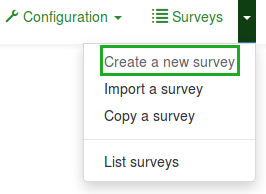
2. La seconde est de cliquer directement sur ce bouton Questionnaires :

Une liste des questionnaires s'affiche. Pour créer un nouveau questionnaire, cliquez sur le bouton Créer un nouveau questionnaire situé en haut à gauche de la fenêtre, au-dessus de la liste de questionnaires.

Créer un nouveau questionnaire
Après le clic sur Créer un nouveau questionnaire, la page suivante s'affiche :
(1) Saisissez le Titre de l'enquête.
Note : Le champ Titre de l'enquête est obligatoire. Les champs restants sont facultatifs. Pour une explication détaillée de chaque champ, veuillez vous référer à la section Éléments de texte ci-dessous.
(2) Cliquez sur Enregistrer (En haut à droite juste en dessous de votre Nom d'utilisateur).
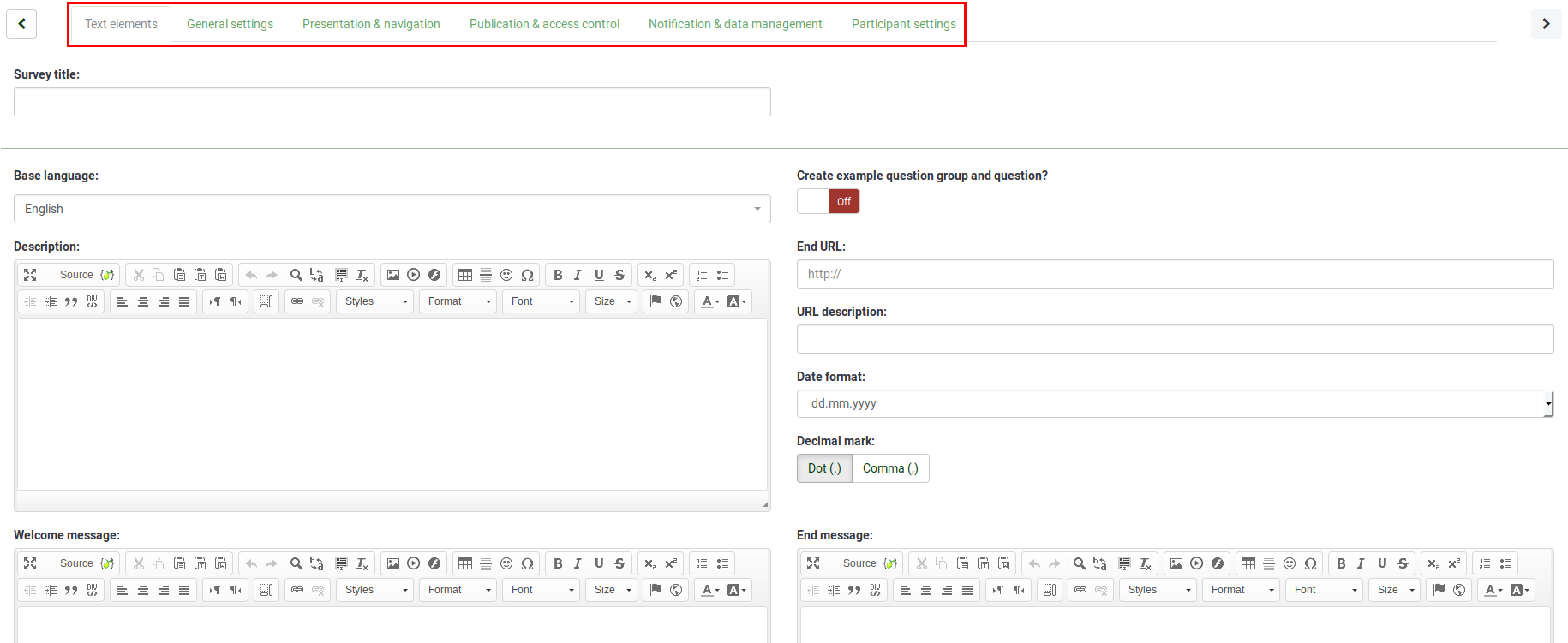
Pour ajuster les options disponibles pour votre questionnaire, vous pouvez parcourir les différents onglets présents dans la barre d'outils Paramètres :
- Paramètres généraux
- Éléments de texte
- Politique de confidentialité
- Options de thème
- Présentation
- Paramètres de participation
- Notifications & données
- Publication & accès
- Text elements
- General settings
- Presentation & navigation
- Publication & access control
- Notification & data management
- Participant settings
Les éléments textuels
Les options suivantes sont disponibles sur cet onglet :
- Titre du questionnaire Le titre du questionnaire peut être modifié depuis ce champ;
- Créer un exemple de question et groupe de question ?: (New in 3.0 ) Si c'est activé, une question et un groupe de question par défaut seront ajoutés à votre questionnaire lorsque vous créez celui-ci;
- Base Language: This represents the main language of the survey. If you wish to add other survey languages, first create a survey, then access the general settings of the newly created survey and add additional languages.
- Description: You can type in a survey description. If enabled from the global settings, you can use the HTML editor to better customize the description field.
- End URL: You have the possibility to redirect users to another page when they finish filling out the questionnaire. If you wish to redirect them, type in the URL and activate the automatically load URL option that is located under the Presentation & navigation tab.
- URL Description: A short end URL description can be added in instances where the user is redirected to a non-related survey webpage. It may help if the survey administrator adds notes relating to the usage of the respective URL.
- Date Format: This option is important when you want to record timestamps together with the survey participants' answers. If you click on it, a drop-down list will show up with a several date formats. Choose the date format used in the geographical location of your respondents. Do not forget that different date formats are used across the world. For example, it is recommended that you use a different time format if your questionnaire focuses on the US market (mm-dd-yyyy) and not on the British market (dd-mm-yy).
- Decimal Mark: Two options are available: dot (.) and comma (,). Choose the one that fits the place (the geographical location) where you conduct your study (e.g. US vs Germany).
- Welcome Message: Type in a message that will welcome the survey participants when they access your survey link.
- End Message: Type in a message that will be displayed to the survey participants once they finish the questionnaire. If the end URL field is automatically loaded, the end message is no longer displayed.
Paramètres généraux
Les options suivantes sont disponibles sur cet onglet :
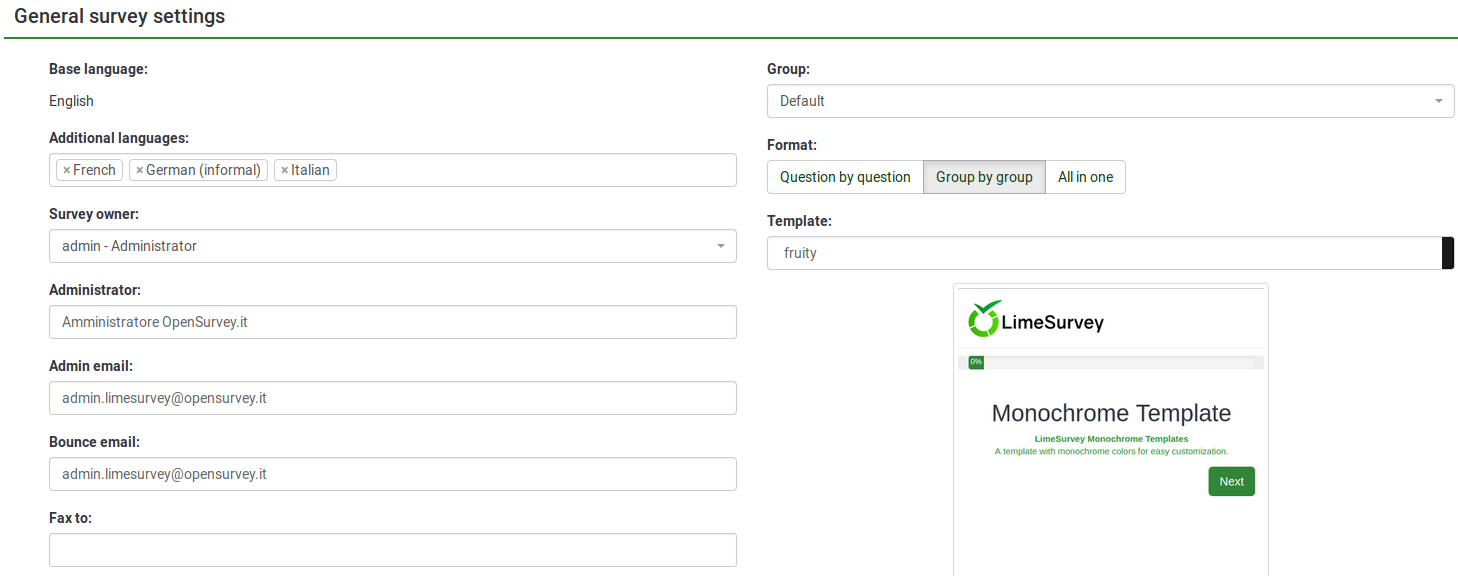
- Survey Owner: Type in the real name of the survey owner.
- Administrator: The name of the administrator.
- Admin Email: Type in the email address of the survey administrator.
- Bounce email: This is the email address where the delivery error notification emails (bounced emails) will be sent to.
- Fax To: This field is used to print a fax number on the "printable survey" - i.e.: when you want to send someone a hard copy because he or she cannot use the online survey.
- Group (New in 3.0 ): Select the survey group that the newly created survey should be added to.
- Format: This function allows you to choose the way in which the questions will be displayed to the survey respondents. Three options are available:
- Question by Question : The questions will be displayed one by one (one question per page). If this option is chosen, a separate "welcome" page and "end" page will be displayed when taking the survey.
- Group by Group : Each survey page will display a question group. Also, a separate "welcome" page and "end" page will be displayed when taking the survey, as with the "Question by Question" surveys.
- All In One : If chosen, all the pages will be displayed on a single page. If you select this option, no separate pages will be displayed for the "welcome" and "end" pages - they will all appear on the same page, together with the questions.
- Template: The default template is rather simple, but functional. More information on creating your own templates is available here.
The following options can be found under the Presentation & Navigation tab:
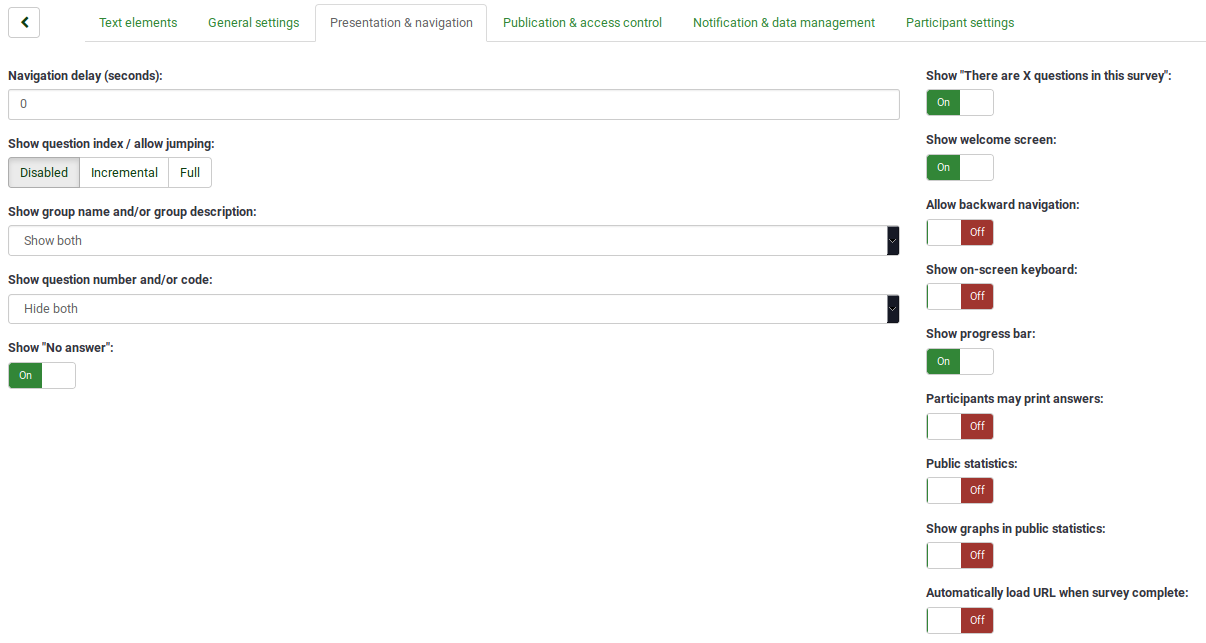
- Navigation Delay (Seconds): This feature displays the number of seconds before the previous, next, and submit buttons are enabled. If none is specified, the option will use the default value, which is "0" (seconds).
- Show Question Index / Allow Jumping: A question index can be displayed in the survey if this function is enabled, allowing the user to jump from one question group to another. You can choose the following:
- Disabled : If this option is selected, no index is shown in the survey.
- Incremental : If this option is selected, the question groups will be shown incrementally in an index menu located on the survey page. You are allowed to "jump back" only to the question groups that were previously visited/accessed.
- Full : Jumping from question group to question group is allowed via the index menu.
- Show "There Are X Questions In This Survey": This shows the total number of questions in your survey.
- Show Group Name and/or Group Description: This function allows you to choose whether your survey will show participants the question group name only, the group description only or both. You may also choose to hide both.
- Show Question Number and/or Code: This function allows you to choose whether your survey will show participants the question number only, the question code only or both. You may also choose to hide both. Please note, the question number is shown the moment someone starts the survey, while the question code is shown next to each survey question.
- Show "No Answer": When a "radio button" or "select type" question that contains editable answers (e.g.: List & Array questions) has the Show "No Answer" option enabled and it is also not mandatory, an additional entry "No Answer" is displayed for each question/sub-question. In this way, the respondents may choose not to answer the respective question/sub-question. The following two options are available for survey administrators:
- On : If this option is selected, the respondents can choose the "No Answer" option for a non-mandatory question.
- Off : If selected, the "No Answer" option will not be displayed as a possible answer for any non-mandatory question.
- Show Welcome Screen: If turned off, the welcome text message will not be displayed at the beginning of the questionnaire.
- Allow Backward Navigation: If enabled, this will allow the users to navigate backwards and change his or her previous answers.
- Show On-Screen Keyboard: If turned on, an on-screen keyboard will will be displayed when answering questions that require typing in information.
- Show Progress Bar: When enabled, this function displays a progress bar that shows participants how much of the survey they have completed and how much is left to be completed.
- Participants May Print Answers: If turned on, the survey participants may choose at the end of the survey to print their answers.
- Public Statistics: A link to a set of statistics will be shown at the end of the survey if this option is enabled.
- Show Graphs In Public Statistics: If enabled, graphs will also be shown in the Public Statistics at the end of the survey. Please note that the "Public Statistics" option has to be enabled to allow the survey participants to see the graphs.
- Automatically Load URL When Survey Complete: The end URL becomes a redirect link once the survey is completed if this option is turned on.
Publication & access control
The following options can be found under the Publication & Access Control tab:
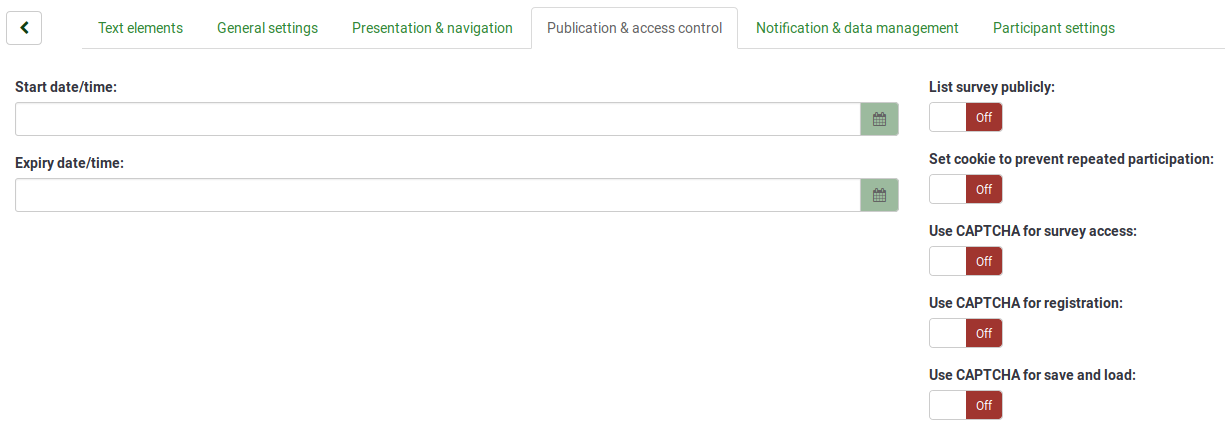
- Start Date/Time: This is the date/time the survey starts.
- Expiry Date/Time: This function allows you to choose a date for your survey to expire. This is the last date on which the public survey script will let people participate. (Example: If you set the expiry date for the 31st of December, then people will no longer be able to fill out the survey on the 1st of January). To remove an expiry date, just clear the date from the input field.
- List Survey Publicly: The default value is "No". When it is set to "Yes", your survey will be listed in the "Available Surveys" portal where it can be seen by all LimeSurvey users.
- Set Cookie to Prevent Repeated Participation: If this is turned on, a survey participant will be blocked from completing a survey a second time.
- Use CAPTCHA for Survey Access: In order to access the survey, a CAPTCHA code has be typed in by the survey participant.
- Use CAPTCHA for Registration: In order to register for the survey, a CAPTCHA code has be typed in by the survey participant.
- Use CAPTCHA for Save and Load: Enable this function if you want a survey participant to type in a CAPTCHA code when he or she loads the survey again after only a part of it was completed (to prevents automated responses).
Notification & data management
The following options can be found under the Notification & Data Management tab:
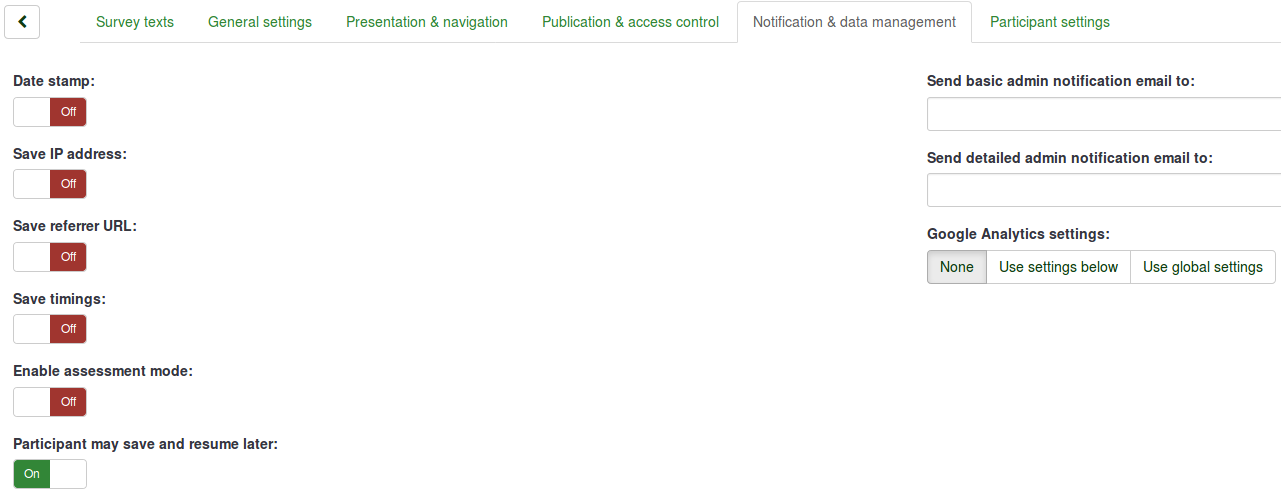
- Date Stamp: Enable this functionality if you would like to see the time when the answers were submitted.
- Save IP Address: If "yes" is selected, the IP address of the survey respondent will be stored together with his or her answers.
- Save Referrer URL: If "yes" is selected, the referrer URL will be stored together with the answers.
- Save Timings: If this functionality is enabled, the time spent on each page of the survey by each participant is recorded.
- Enable Assessment Mode: You can enable/disable assessments for this survey with this setting.
- Participant May Save and Resume Later: This setting allows a participant to save his/her responses and resume the survey at a later time. Please note that this is most useful with open surveys or surveys in which the participants are anonymous. If you are using tokens and the survey is not anonymous, in most cases it is better to activate token-based response persistence from the Participant settings panel.
- Send Basic Admin Notification Email To and Send Detailed Admin Notification Email To: These two functions allow you to send notifications or survey responses to any email address once the survey is submitted. You can edit the templates for these emails from the Email templates menu. You can choose the option to send emails to multiple recipients simultaneously by separating the email address entries with a semicolon (;) (e.g "yourname@test.com; myname@test.com; hisname@test.com" or (if using placeholders) "yourname@test.com;{INSERTANS:82733X12X73};{TOKEN:EMAIL}").
There are different ways for entering an email address:
- Enter a specific email address (ie: yourname@test.com).
- Enter a SGQA code and the response will be sent to an email address entered as an answer to that particular question (use the format {INSERTANS:9999X88X12} in the same way you would reuse information from previous answers).
- The following is only possible if your survey is not anonymous. Enter a token code and the response will be sent to an email address retrieved from a token field. Use the format {TOKEN:EMAIL} or {TOKEN:ATTRIBUTE_1} in the same way you would re-use Information from the Survey participants table.
- Google Analytics Settings: If you would like to get details about the survey web traffic, use Google Analytics. Three options are available:
- None : Google Analytics will not be used.
- Use Settings Below : If this option is chosen, the survey owner can type in his or her Google Analytics Tracking ID to be stored only with the respective survey. You also have the ability to choose one of the three Google Analytics styles.
- Do Not Use Google Analytics - so {GOOGLE_ANALYTICS_JAVASCRIPT} is an empty string.
- Default Google Analytics - {GOOGLE_ANALYTICS_JAVASCRIPT} uses the standard Google Analytics code, inserting the proper Google Analytics Key.
- SurveyName-[SID]/GroupName - {GOOGLE_ANALYTICS_JAVASCRIPT} contains customized Google Analytics code to log the URL as {SURVEYNAME}-[{SID}]/{GROUPNAME}. This can be helpful if you want to analyze navigation paths through your survey, time spent per page, and drop-off rates per page.
- Use Global Settings : If this option is chosen, the survey will use the same Google Analytics Tracking ID as the one saved in the global settings and then you choose the desired Google Analytics style.
Invitations
Les options suivantes sont disponibles :
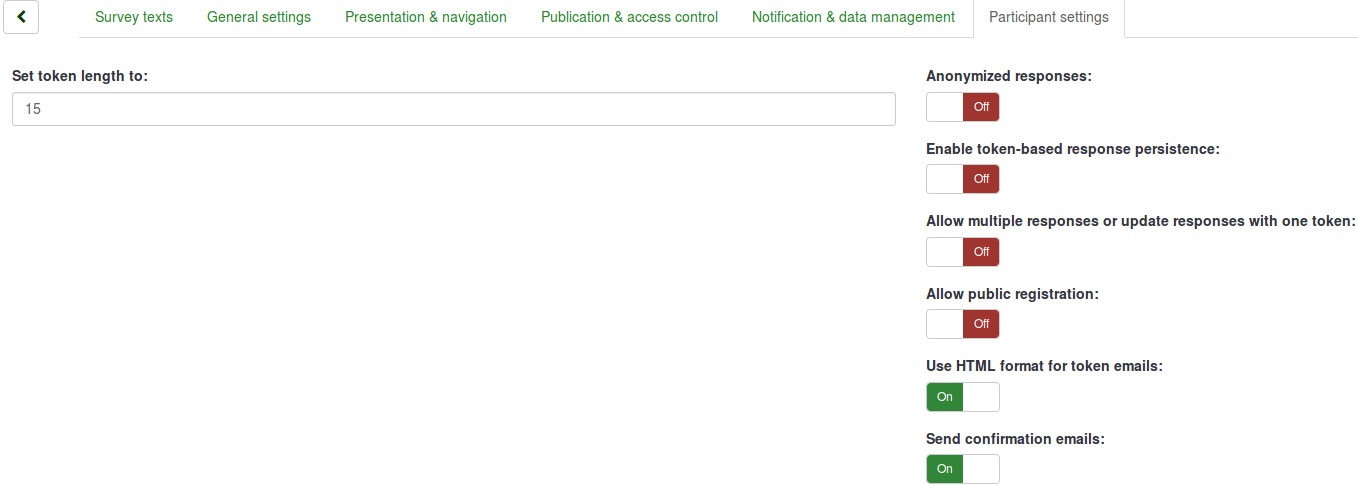
- Définir la longueur du code à : Habituellement la valeur par défaut de 15 (valeur max; supportée : 35) digits n'a pas à être modifiée. Cependant vous pouvez, si vous le souhaitez, entrer un nombre (X) plus grand que 5. Si ce nombre renseigné est plus petit que 5, il sera alors redéfini à la valeur par défaut de 15. Lorsque vous générerez les codes d'invitation, ceux-ci auront tous une longueur de X digits;
- Anonymized Responses: This functionality allows you to determine whether responses to your survey are matched with information from the Survey Participants table (utilized in the respective survey) or are kept "anonymous". The default is "No". If you choose "Yes", then your survey is set to anonymize responses - there will be no way to connect answers and participants. Even the survey administrator will not be able to link response data and participant/token data. However, you will always be able to specifically view each response entered by your participants in the survey. Thus individual and anonymous analyses can still be done.
- Enable Token-Based Response Persistence: If your survey uses tokens and your responses are not anonymized, you may want to enable this feature. If you enable this feature, your participants will be able to leave the survey and resume later at any time without using the Resume Later function - for example, when they get distracted or their browser crashes. Upon clicking the invitation link again, they will be returned to the point in the survey where they left off with previous entries saved.
- Allow Multiple Responses or Update Responses With One Token: If this option is activated, participants will be able to return to their survey by clicking the invitation link, even if they have already submitted the survey. If the survey is anonymous or "Enable Token-Based Response Persistence" is set to "No", this will add a new response. If the survey is not anonymous and "Enable Token-Based Response Persistence" is enabled, the user will update the existing responses.
- Allow Public Registration: If you use tokens to control access to your survey, the only people who can use the survey are those who have an entry and a unique token code allocated in the Survey participants table. If you would like to use tokens, but also allow public registration, set this to "Yes". The "Yes" setting will allow visitors to register his or her name and email address. The script will create a new entry in your Survey Participants table for this person, then send them an invitation email. The script will ensure that only one person per email address can complete your survey.
- Use HTML Format For Token Emails: When enabled, all emails sent by the token management interface (invite, reminder, confirmation) will be formatted as HTML. You will then be able to use rich formatting for these emails. The default value is "Yes".
- Send Confirmation Emails: If enabled, the participant will receive a confirmation email that the survey was submitted.
Import a survey
You can import a survey from the Create, import, or copy survey screen.
(1) From the Surveys dropdown options (on the top toolbar of your Limesurvey homepage) select Import a survey.
(2) On the Import tab, click Browse and choose the file you wish to import.
(3) Click the Import survey button.

Choose from the following formats:
- .LSS files (XML-format created by LimeSurvey 1.90 or later);
- .LSA files (Survey archive which may include also token, responses and timings - available since LimeSurvey 2.0);
- .TXT files (Text-format created by Excel - available since LimeSurvey 2.0);
- .CSV files (Created by early LimeSurvey versions from 1.50 to 1.90).
The import function "intelligently" re-numbers the survey, groups, questions, answers, and condition IDs so that they all match each other. No existing survey is going to be overwritten during the import process.
By default, the resource links and expression fields are also imported. Basically, the more advanced type of questions are going to be also imported along questions that include complex branching, assessments, validation, and tailoring.
Once the import process is completed, a survey structure import summary will be displayed, showing whether it was successful or not:
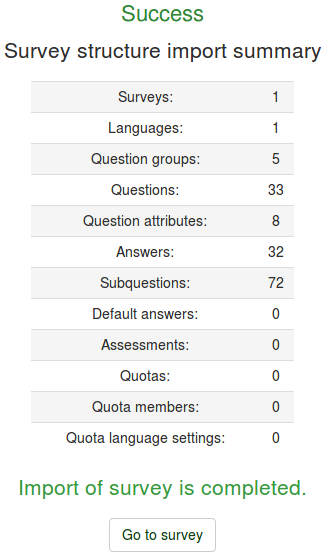
Copy a survey
(1) Access your LimeSurvey homepage and from the Surveys dropdown options (on the top toolbar) select Copy a survey.
(2) From the Copy tab, choose the survey that want to copy from the Select survey to copy options.
(3) Complete the required fields and set preferred options.
(4) Once you are done selecting the preferred options, click the Copy survey button located on the bottom of the page. A survey copy summary will be displayed:
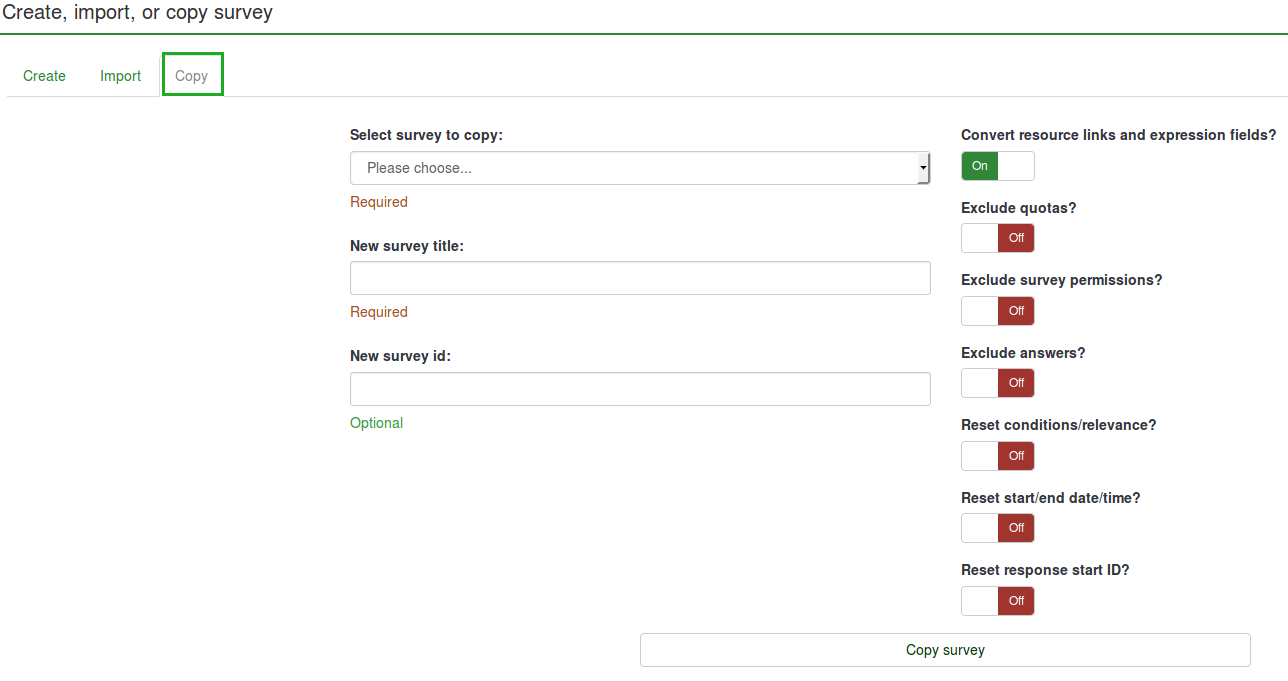
Copy Survey Fields:
- New survey title: Type in the title you wish the copied survey to have.
- New survey id: You can type in a new survey ID or leave the field empty. If the field is left empty, a survey ID will be automatically assigned.
- Convert resource links and expression fields: If you disable this option, the more advanced question types that use the expression manager will not be copied.
- Exclude quotas: The quotas are going to be excluded if this option is disabled.
- Exclude survey permissions: If enabled, no survey permissions will be copied into the new survey.
- Exclude answers: Exclude the answer options.
- Reset conditions/relevance: You can choose to reset the conditions that were set in the original survey.
- Reset start/end date/time?: You can choose to reset the survey start/end date/time.
- Reset response start ID?: Each response has a corresponding ID. If enabled, the ID of the responses will be reset. However, bear in mind that it is better not to have an ID with two matching responses because it might influence the output of your survey.
Below is a screenshot of the Survey Copy Summary.
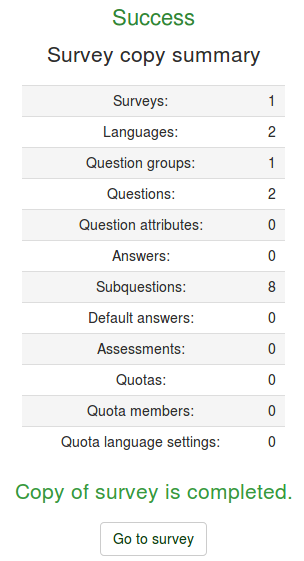
To access the copied survey, click Go to survey to be redirected to the settings of the newly added survey.
List surveys
There are now two ways to see a list of available surveys.
(1) From the Surveys options (on the top toolbar of your LimeSurvey homepage) select List surveys.
(2) Or click the List surveys box on your LimeSurvey homepage.
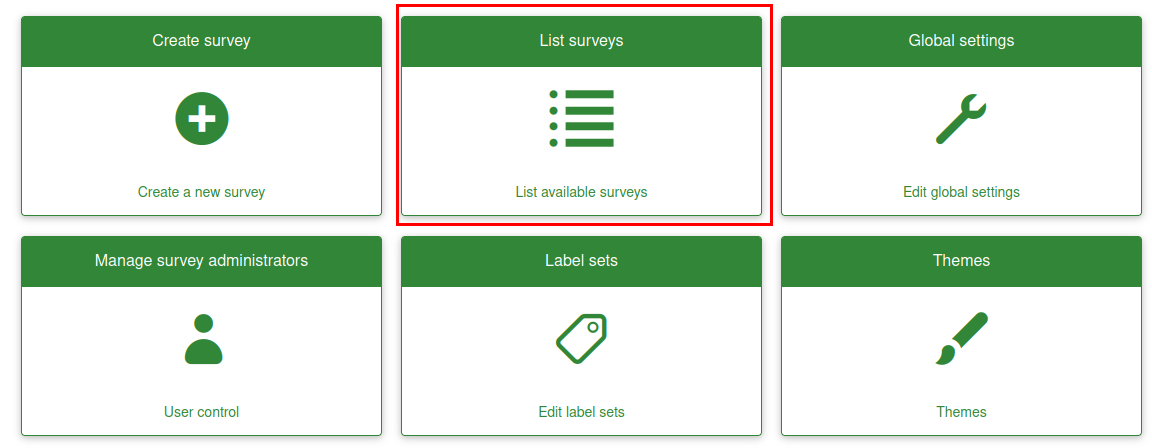
A list of surveys will be displayed.

- Survey ID: When created, the survey receives a unique id that is used to make the connection between different LimeSurvey tables.
- Status: Status of available surveys:
- Title: The title of the survey.
- Group: The survey group to which the survey belongs to.
- Created: The date when the survey was created.
- Owner: The name of the user that owns the survey.
- Anonymized responses: This shows whether the responses are anonymized when stored into the database or not.
- Partial: The number of surveys that were partially completed.
- Full: The number of surveys that were fully completed.
- Total: The number of partially and fully completed surveys.
- Closed group: This is either "Yes" (if a Survey participants table is used) or "No".
- Actions: The last column presents the actions that are available for each survey:

If you want to look for a specific survey, use the search bar and filter the results via the survey status field ("active", "active and running", "inactive", "active but expired", and "active but not yet started").
Delete a survey
(1) From the list of Surveys dropdown options (on the top toolbar of your LimeSurvey homepage) select List surveys.
(2) Select the survey(s) you wish to delete (by ticking the box to the left of the survey ID).
(3) Click on the Selected survey(s)... button located on the bottom-left side of the page.
(4) Select Delete.
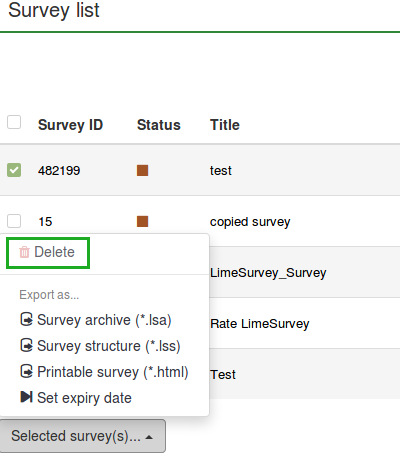
(5) When you click Delete, a confirmation window will appear asking you to confirm your action. Select Yes to confirm.
Export a survey
(1) From the Surveys dropdown options (on the top toolbar of your LimeSurvey homepage) select List Surveys.
(2) Select the survey(s) that you want to export by ticking the box to the left of the survey ID.
(3) Click the Selected survey(s)... box at the bottom of the list of surveys.
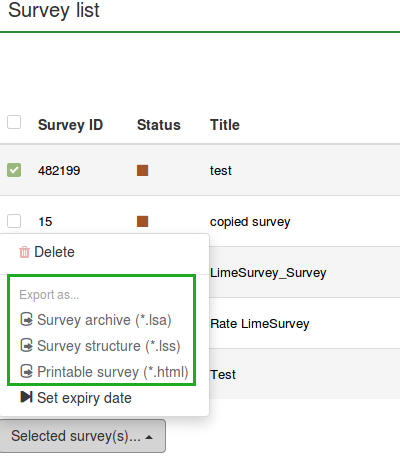
The following options are available:
- Survey archive (*.lsa);
- Survey structure (*.lss);
- Printable survey (*.html): This option allows you to export the survey in a printable format in order to be filled out "offline".
(4) Select the export file type that you want to export the survey as.
For more details, check how to export a survey structure.
Survey groups
(1) To access the survey group functionalities, click Surveys located on the main toolbar of the LimeSurvey home page.
(2) Then click the Survey groups tab:

A survey groups list will be displayed.
On this page you can:
- Create a survey group - located above the survey groups table;
- Edit a survey group - located on the last column (the green pencil icon);
- Delete a survey group - located on the last column (the red trash icon).
Create a survey group
To create a new survey group:
(1) Click Surveys located on the main toolbar of the LimeSurvey home page.
(2) Click the Survey groups tab.
(3) Click the Create a new survey group button located above the survey groups list.
(4) Complete the following fields and Save:
- Name: Type in the name of the survey group;
- Title: Type in the title of the survey group;
- Description: Type in a short description of the survey group;
- Order: Helps you organize the order of the survey groups within a parent group;
- Parent: Choose the survey group that will be the parent survey group. The parent group option is used to ease the edit of template-related options of a high number of survey groups via a few clicks.
To add surveys to the group:
(1) Go to the General settings tab of a survey.
(2) Click the arrow in the Group field to display a list of survey groups.
(3) Select the survey group and Save.
Edit survey group
The following options of a survey group can be edited:
- Surveys in this group;
- Settings for this survey group;
- Template options for this survey group (New in 3.0 ).
(1) From the top toolbar of your LimeSurvey homepage, click Surveys.
(2) Click the Survey group tab.
(3) Select the survey group that you want to edit, by clicking the edit icon under the Actions column.
The survey group will be displayed in edit mode.
Surveys in this group
If you click on the first tab, all the surveys from the respective group will be displayed.

This works as a filtering function, filtering out all the surveys not listed in the chosen survey group. You can now select the desired survey and start editing it. To see which survey-editing functionalities are available, check the list surveys section.
Settings for this survey group
The following fields can be edited from the Settings for this Surveygroup tab:
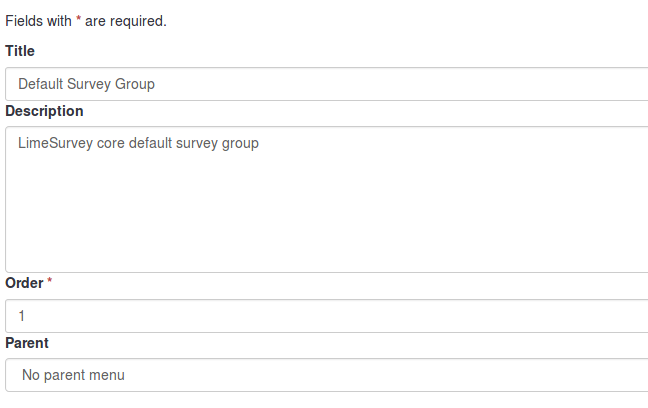
- Title: Type in the title of the survey group;
- Description: Type in a short description of the survey group;
- Order: Helps you organize the order of the survey groups within a parent group;
- Parent: Choose the survey group that will be the parent survey group. The parent group option is used to ease the edit of template-related options to a higher number of survey groups via a few clicks.
Template options for this survey group
The template options functionalities are present in LimeSurvey 3.0+. It offers a set of various options that allows you to quickly and easily change the templates-related settings of the surveys that belong to the same survey group:
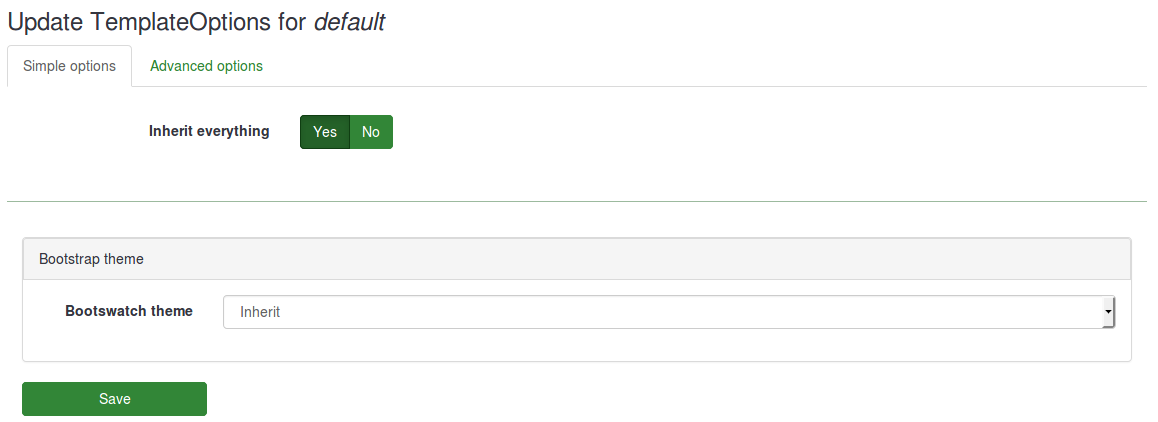
The Inherit everything functionality lets you decide whether you want the survey group to inherit everything or not from the parent survey group theme.
If you do not want this to happen, select "No". The following options will show up which will allow you to choose what should be inherited from the parent survey group theme:
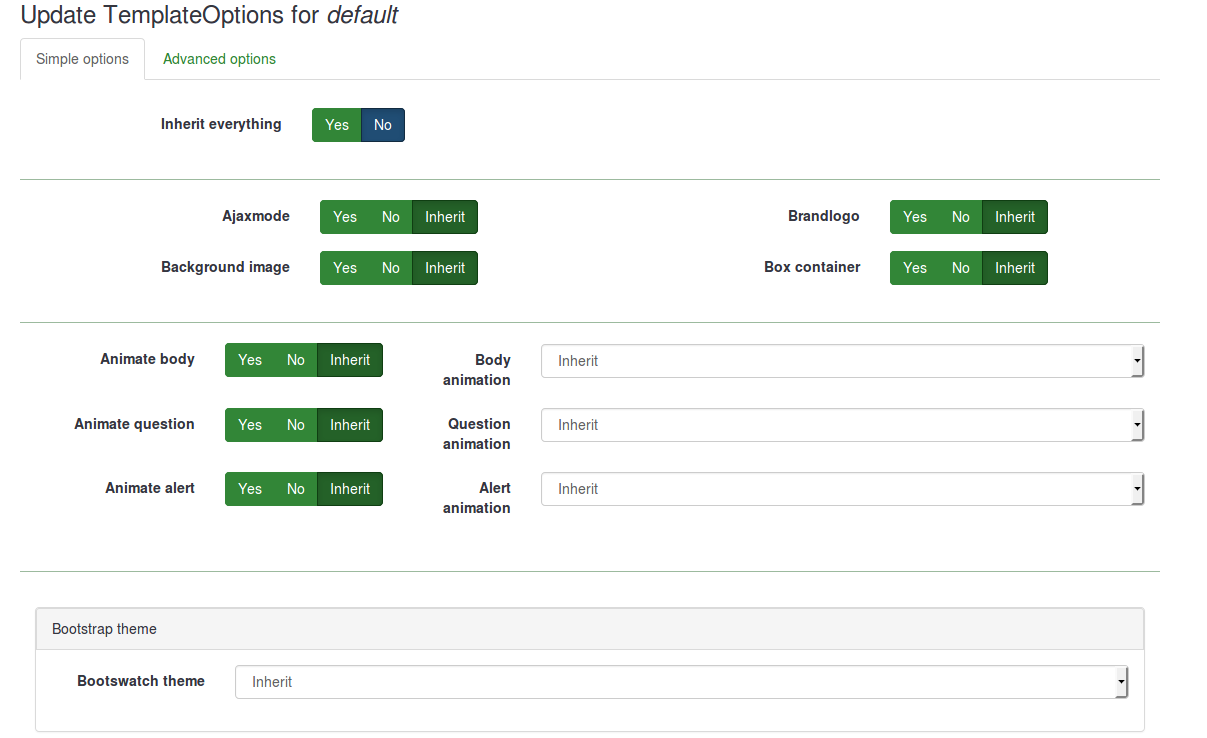
Below, you will see that you can choose a bootswatch theme for your survey group. Bootswatch themes can be used to quickly edit your templates. Basically, bootswatch is a collection of themed swatches which can be freely downloaded and dropped into your Bootstrap site. Some of these themes are already included into your LimeSurvey installation and they can be selected from the Bootswatch theme drop-down list.
If you want to tweak more a survey group template options, click on the advanced option tab (recommended for advanced users):
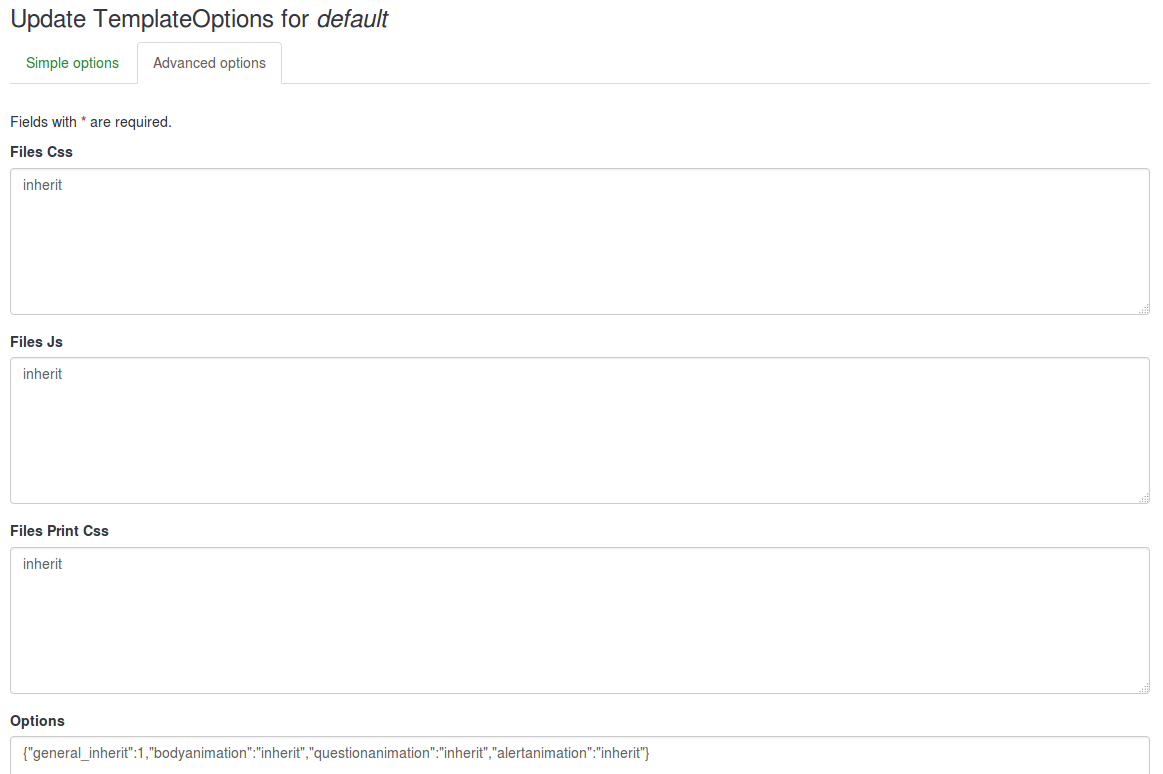
Delete a survey group
(1) Display a list of your surveys. (From the Surveys tab on the top toolbar of your LimeSurvey homepage, click List surveys or click the List surveys box).
(2) Click the Survey group tab.
(3) Select the survey group you want to delete and click the Delete icon located in the Actions column.
(4) Confirm the deletion by clicking Yes.
